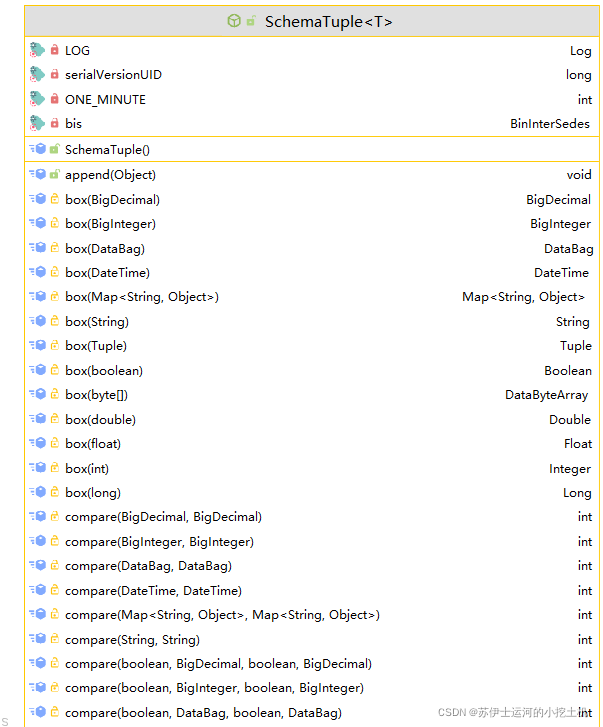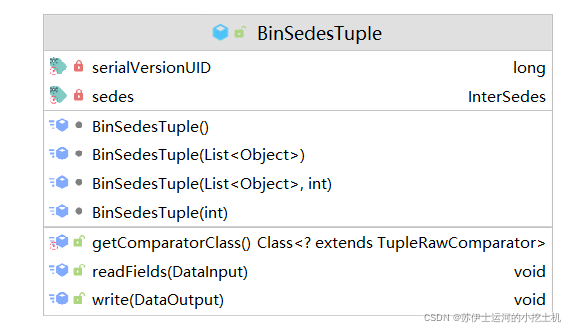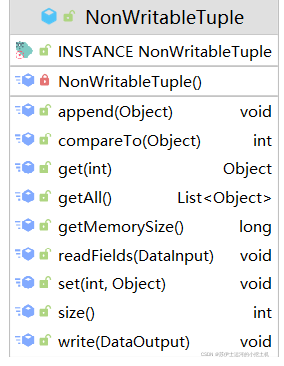2021SC@SDUSC?

?上篇我们讲解了AmendableTuple,本篇继续讲解其他元组
其他元组
AppendableSahemaTuple
ApendableSachemaTuples是一个抽象类,其UML如下

?继承关系
public abstract class AppendableSchemaTuple<T extends AppendableSchemaTuple<T>> extends SchemaTuple<T>
?继承自SchemaTuple这个也没有接触过,并且该类也没有任何注释,也没有测试函数,由于是抽象类甚至没有构造函数,于是只能大致看一下public的方法
@Override
public void append(Object val) {
??? if (appendedFields == null) {
??????? appendedFields = mTupleFactory.newTuple();
??? }
??? appendedFields.append(val);
}
public SchemaTuple<T> set(List<Object> l) throws ExecException {
??? int listSize = l.size();
??? int schemaSize = schemaSize();
??? if (listSize < schemaSize) {
??????? throw new ExecException("Given list of objects has too few fields ("+l.size()+" vs "+schemaSize()+")");
??? }
??? Iterator<Object> it = l.iterator();
??? generatedCodeSetIterator(it);
??? resetAppendedFields();
??? while (it.hasNext()) {
??????? append(it.next());
??? }
??? return this;
}
public void set(int fieldNum, Object val) throws ExecException {
??? int diff = fieldNum - schemaSize();
??? if (diff >= 0 && diff < appendedFieldsSize()) {
??????? setAppendedField(diff, val);
??? } else {
??????? super.set(fieldNum, val);
??? }
}
set函数将 ObjectList里的数据加入到了Tuple中
接下来看看它的父类
SchemaTuple
继承关系
public abstract class SchemaTuple<T extends SchemaTuple<T>> extends AbstractTuple implements TypeAwareTuple {?
UML
大小很大,只能给出部分了

一些注释
/**
?* SchemaTuple 是一种类型感知元组,速度更快,内存效率更高。在我们的实现中,给定一个 Schema,
?* 代码生成用于扩展这个类。此类提供了广泛的功能,可最大限度地降低必须生成的代码的复杂性。
?* 奇怪的通用签名允许进行某些优化,例如“setSpecific(T t)”,它允许我们在类型匹配时进行更快的设置和比较
?* (因为代码是生成的,没有其他方法可以知道)。
?*/
?这个类很有意思,是一个快速代码生成器,推测是Pig Latin实现的组成部分,它的成员方法有很大部分是用于实现代码生成的,说实话已经超出了数据结构分析的范围,而是在探讨系统实现了,并且有部分是抽象方法,例如刚才ApendableSachemaTuple实现的方法
为了进一步理解,我们直接看它的父类TypeAwareTuple,是一个接口,代码如下
public interface TypeAwareTuple extends Tuple {
??? public void setInt(int idx, int val) throws ExecException;
??? public void setFloat(int idx, float val) throws ExecException;
??? public void setDouble(int idx, double val) throws ExecException;
??? public void setLong(int idx, long val) throws ExecException;
??? public void setString(int idx, String val) throws ExecException;
??? public void setBoolean(int idx, boolean val) throws ExecException;
??? public void setBigInteger(int idx, BigInteger val) throws ExecException;
??? public void setBigDecimal(int idx, BigDecimal val) throws ExecException;
??? public void setBytes(int idx, byte[] val) throws ExecException;
??? public void setTuple(int idx, Tuple val) throws ExecException;
??? public void setDataBag(int idx, DataBag val) throws ExecException;
??? public void setMap(int idx, Map<String,Object> val) throws ExecException;
??? public void setDateTime(int idx, DateTime val) throws ExecException;
??? public int getInt(int idx) throws ExecException, FieldIsNullException;
??? public float getFloat(int idx) throws ExecException, FieldIsNullException;
??? public double getDouble(int idx) throws ExecException, FieldIsNullException;
??? public long getLong(int idx) throws ExecException, FieldIsNullException;
??? public String getString(int idx) throws ExecException, FieldIsNullException;
??? public boolean getBoolean(int idx) throws ExecException, FieldIsNullException;
??? public BigInteger getBigInteger(int idx) throws ExecException;
??? public BigDecimal getBigDecimal(int idx) throws ExecException;
??? public byte[] getBytes(int idx) throws ExecException, FieldIsNullException;
??? public Tuple getTuple(int idx) throws ExecException;
??? public DataBag getDataBag(int idx) throws ExecException, FieldIsNullException;
??? public Map<String,Object> getMap(int idx) throws ExecException, FieldIsNullException;
??? public DateTime getDateTime(int idx) throws ExecException, FieldIsNullException;
??? public Schema getSchema();
}
内容就是set、get了一堆数据类型
BinSedesTuple
一些注释
/**
?* 这个元组有一个更快的(反)序列化机制。它用于存储 Map 和 Reduce 之间以及 MR 作业之间的中间数据。
?* 这仅供内部猪使用。序列化格式可以更改,因此不要使用它来存储任何持久数据(即在加载存储函数中)。
?*/
继承关系(终于不是抽象类了)
public class BinSedesTuple extends DefaultTuple?
构造函数很简单粗暴,全部super()
BinSedesTuple() {
?? super();
}
/**
?* 构造一个具有已知字段数的元组。包级别,以便调用者不能直接调用它。
?* @param size Number of fields to allocate in the tuple.
?*/
BinSedesTuple(int size) {
??? super(size);
}
/**
?* 从现有的对象列表构造一个元组。包级别,以便调用者不能直接调用它。
?* @param c List of objects to turn into a tuple.
?*/
BinSedesTuple(List<Object> c) {
??? super(c);
}
唯一和父类有区别的地方就是下面这个结构了
private static final InterSedes sedes = InterSedesFactory.getInterSedesInstance();
public static Class<? extends TupleRawComparator> getComparatorClass() {
??? return InterSedesFactory.getInterSedesInstance().getTupleRawComparatorClass();
}
?可以理解为就是普通tuple+interSede
最后给出UML

NonWritableTuple
一些注释?
/** ?* A singleton Tuple type which is not picked up for writing by PigRecordWriter ?* 未被PigRecordWriter选取用于写入的单例元组类型 ?*/
继承关系???
?public class NonWritableTuple extends AbstractTuple {
?
值得一提的是DefaultTuple也继承于AbstractTuple?
UML图

构造函数直接是空的!(真 未写入的Tuple)显然这是个处理过程中间用的Tuple,用完就丢的那种
TargetedTuple?
一些注释
/**
?* A tuple composed with the operators to which
?* it needs be attached
?*由需要附加的运算符组成的元组
?*/
继承关系
public class TargetedTuple extends AbstractTuple
UML

?从描述来看,此Tuple有一个存储运算符的数据结构,即tagetOps,推测是类似计算机计算算术的时候采用的方法,把数字和运算符放进一个栈结构中,然后一个个取出来处理
TimestampedTuple?
继承关系
?public class TimestampedTuple extends DefaultTuple {
UML图?

有两个重要的成员timestamp(时间戳)、heartbeat?,由于没有注释不知道具体是做什么用的
?protected double timestamp = 0;????? // 这个元组的时间戳
??? protected boolean heartbeat = false;? // 如果这是一个心跳,则为真(即目的只是传达新的时间戳;不携带数据)?
构造函数
?public TimestampedTuple(int numFields) {
??????? super(numFields);
??? }
???
??? public TimestampedTuple(String textLine, String delimiter, int timestampColumn,
??????????????????????????? SimpleDateFormat dateFormat){
??????? if (delimiter == null) {
??????????? delimiter = defaultDelimiter;
??????? }
??????? String[] splitString = textLine.split(delimiter, -1);
??????? mFields = new ArrayList<Object>(splitString.length-1);
??????? for (int i = 0; i < splitString.length; i++) {
??????????? if (i==timestampColumn){
??????????????? try{
??????????????????? timestamp = dateFormat.parse(splitString[i]).getTime()/1000.0;
??????????????? }catch(ParseException e){
??????????????????? log.error("Could not parse timestamp " + splitString[i]);
??????????????? }
??????????? }else{
??????????????? mFields.add(splitString[i]);
??????????? }
??????? }
??? }
?
总结
Tuple作为Pig中最小的数据结构,其变种并没有很多可讲的内容,因为大部分只是在原有基础上添加了少量的内容,想要理解这些Tuple具体的作用,必须放到实际的应用场景当中,因此本篇讲得都比较浅,因为讲多了没用。
本篇的内容就到这里,下一篇将讲一讲几个数据结构的工厂。